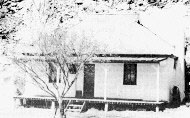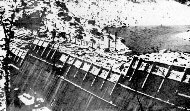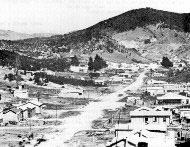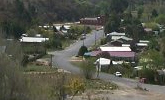| Captain's Flat mine owners
had requested the government to build a railway line
from Bungendore to ship ore out. However after surveying
the mines, it was deemed that the ore was of
insufficient quality and contained too much lead and
zinc making smelting difficult, to justify the expense.
The request for a railway was refused.
Towards the end
of 1899, the mines ceased smelting copper and turned its
attention once more to gold. A cyanide treatment plant
was built to treat the gold-bearing ore (gossam), but
this was a complete failure. Lake George Mines Company
ceased its operations and after the dismantling of the
equipment was completed, the town fell silent.
In a matter of days, the population fell from over
2000 to less than 300, despite local belief that the
mines would soon reopen. A push was made to have
Captain's Flat tendered as the site for the planned
national capital, but as the water supply was poor and
unreliable, this was never really considered. Finally it
was realised that the Captain's Flat boom period was
over and the town settled into a moody silence and
threatened to become a ghost town.
Mr. Channon maintained the leases and kept pumps
working in the shafts to prevent flooding, but this was
the full extent of the mine workings. Captain's Flat
dropped out of the public eye, its population continued
to dwindle and it remained that way for nearly forty
years, despite a series of test drilling made in 1925.
National Mining Corporation, a British company,
conducted £42,000 worth of tests which resulted in the
mines reopening for the extraction of iron pyrites to be
shipped to Port Kembla. The mining leases were taken up
again by the newly reborn Lake George Mines Company,
shares increased in value and small scale mining began.
Some 2,320 tons of ore was treated in the initial
plant and by 1937, ore reserves were estimated at
5,000,000 tons. Large scale mining production was
approved and it looked like the town was on the way
back. |

This little house was built by Jack Bollard using bricks
from the smelter chimney. It is the last house heading
south out of town on the Jerangle Road.

The newly constructed company dam across the Molonglo
River (circa 1930)

Looking north at Newtown in the late 1930's before the
hospital was built |

